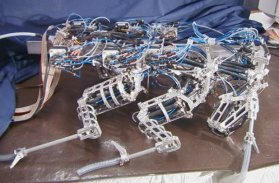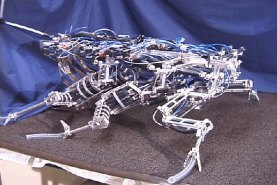Robot V (Ajax) is another cockroach inspired robot, following in many ways after Robot III. The robot uses the same joint architecture as the previous robot: five joints in the front legs, four in the middle, and three in the rear, for a total of 24 degrees of freedom. Robot V is larger than Robot III and uses different actuators. Robot III is 17 times the size of Blaberus discoidalis; Robot V is 20 times the size of the animal. Robot III used pneumatic pistons for actuators while Robot V uses McKibbens.
This animation shows the DOF of the front leg.
Ajax uses braided pneumatic actuators to power all 24 degrees of freedom; however, the actuators are slightly modified variations of Fluidic Muscle made by the Festo Company. Because these are pull-only devices, they must be used in opposing pairs. Two two-way valves control each actuator, allowing air to not only be inlet and exhausted, but trapped as well. As a result, the robot is able to control not only joint position, but also joint stiffness.
One very important property of the actuators used on Robot V is their inherent passive stability. When the robot is perturbed, it will naturally return to its equilibrium state.
Ajax is capable of maintaining a tripod stance, where the middle leg on one side, and the front and rear legs on the other side support the weight of the entire body. This is a necessity if tripod walking is to be achieved. While in this state, the robot exhibits the same passive stability properties as shown above.
The robot is also capable of switching from tripod to tripod. This is effectively walking – many of the leg motions are the same, although there is very little forward motion. Note that there is a 5 pound payload on the back of the robot in this movie.
Robot V walking with a 5 lb payload.


